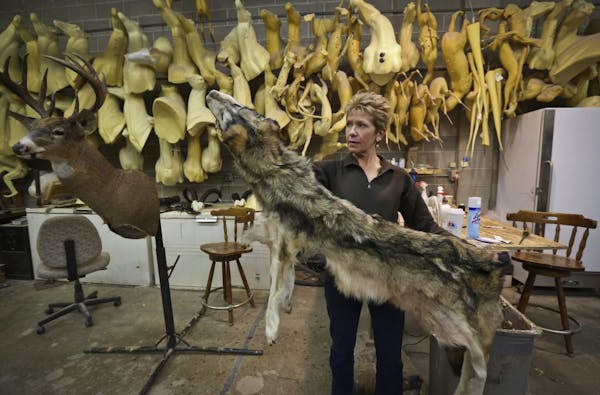The number of wolves hunters can kill in Minnesota this fall will be slashed nearly in half, from 400 a year ago to 220, the Department of Natural Resources said Monday.
And only 3,300 hunters and trappers will be given permits this year to kill wolves, down from 6,000.
The cutbacks follow a survey last winter that estimated the state's wolf population at 2,211 — a 24 percent decline from 2008, but a figure that doesn't include this year's surviving pups.
The announcement renewed a contentious debate in a dispute that has simmered in Minnesota for decades, since before the wolf was protected by the federal Endangered Species Act in 1974. The controversy peaked last fall with the first managed hunting and trapping season.
DNR wolf expert Dan Stark said his agency isn't worried about the state's wolves. "We're continuing to be conservative in our approach,'' he said.
However, those on both sides of the issue expressed outrage Monday over the DNR's changes to this year's hunt.
Maureen Hackett, founder of Howling for Wolves, said Minnesota wolves "quite possibly are on their way down,'' and that hunting and trapping threaten their population. "A random hunt that kills wolves for pleasure might dramatically reduce the ability of wolves to reproduce themselves,'' she said.
But Mark Johnson, Minnesota Deer Hunters Association executive director, saw it differently.
"It looks like the DNR bowed to pressure from the anti-hunting groups,'' he said. "I'm skeptical why they cut the harvest quota 45 percent, yet the population survey showed only a 24 percent decline in wolves.''
Added Julian Brzoznowski of Orr, Minn., a retired cattleman whose livestock operation was plagued for many years by wolves: "Cutting the hunters' wolf quota is crazy. Wolves are still everywhere up here. The hunters took a few out, but the pups will replace those animals real quick.''
Stark said the DNR's goal is to protect the state's wolves while also providing hunting and trapping opportunities. He said the wolf population — the largest in the Lower 48 states — remains healthy and well above the 1,600 minimum goal established in the state's wolf management plan.
"We're just allowing the taking of wolves through hunting and trapping in a way we think is sustainable and not going have a major influence on overall wolf numbers,'' he said.
Stark said officials believe the wolf population fell from 2008 because of a 25 percent decline in the deer population and a mild winter in 2011-12 made it difficult for wolves to catch deer, their main prey. Last winter was more severe, and he expects wolves did well.
"We could have a higher population than last year,'' he said. Officials will radio-collar more wolves this winter to try to determine population changes. The comprehensive winter population survey is done every five years.
On the plus side, livestock depredations caused by wolves are down significantly this year, as are the number of problem wolves killed so far by federal and state trappers. As of last week, about 20 wolves had been killed, compared with about 200 at this time last year. Nearly 300 problem wolves eventually were killed last year, and Stark said the removal of those animals from farms — and not the wolf hunting and trapping season — likely explains the decline in complaints this year.
Also, he said there's a correlation between mild winters, when wolves have trouble getting food, and livestock depredations the following spring. Last winter's severity likely enabled wolves to eat well, reducing their need to prey on livestock.
Hunters and trappers can apply for the licenses beginning Thursday. Successful applicants will be selected in a lottery. The deadline to apply is Sept. 5.
Meanwhile, a federal suit by four wildlife advocacy groups challenging the U.S. Fish and Wildlife Service's decision to remove wolves from the federal endangered species list has yet to be heard.
The Minnesota Court of Appeals in May threw out a challenge to the wolf season by the Center for Biological Diversity and Howling for Wolves, saying the groups had no legal standing to sue because they couldn't show the DNR had caused injury. The judges noted that the Legislature, not the DNR, established a season on wolves.
Staff Writer Dennis Anderson contributed to this report.
Doug Smith • 612-673-7667

Baseball Metro Player of the Year packs up his five tools and leaves

Prep baseball 2024: 35 Minnesota stars who the recruiters covet
Police searching for St. Paul home intruder who raped, robbed woman

Friend heard money, relationship woes from man tied to Chanhassen killing who took his own life

